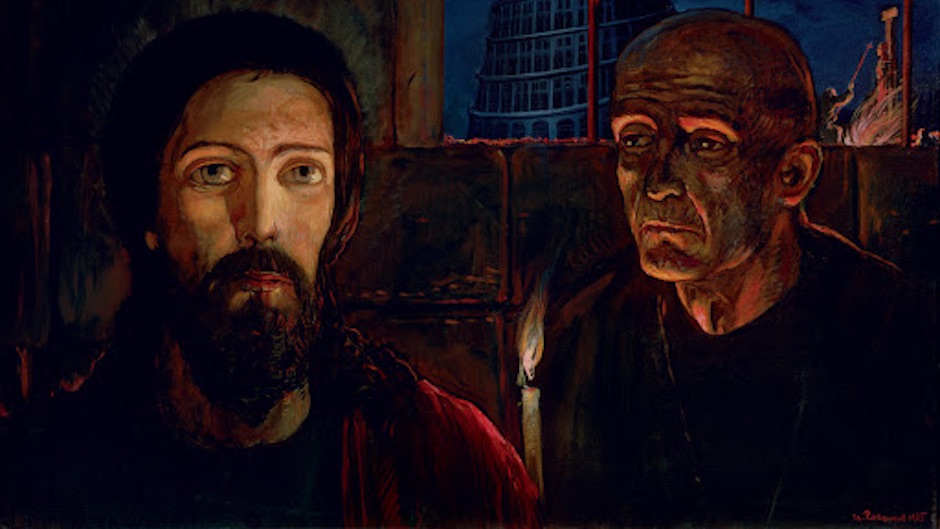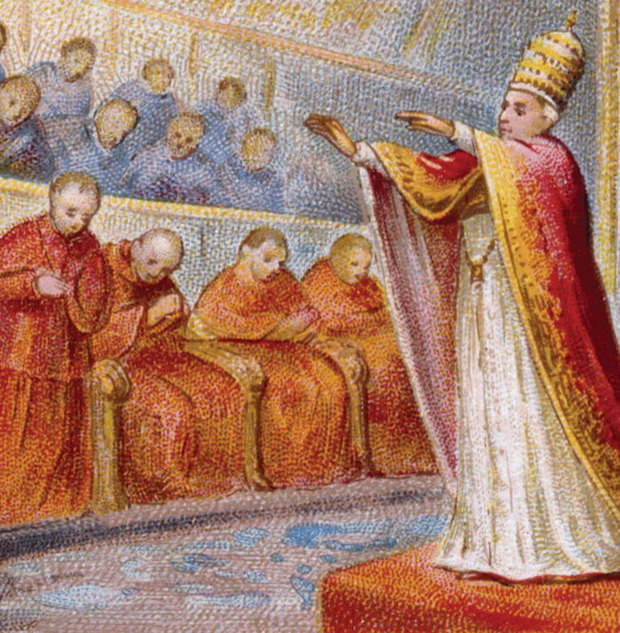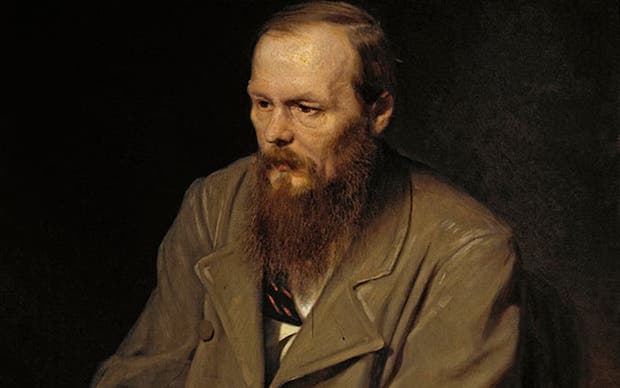In the face of death, a desperate person can find life in Jesus Christ. That was the experience of the Russian writer Dostoevsky when he was condemned to death along with his fellow revolutionaries.
 The devastating thing is that Dostoyevsky does not describe a caricatural cardinal, but rather an ascetic individual “wearing his coarse, old, monk’s cassock”. It is the Church of Rome in its ideal expression.
The devastating thing is that Dostoyevsky does not describe a caricatural cardinal, but rather an ascetic individual “wearing his coarse, old, monk’s cassock”. It is the Church of Rome in its ideal expression.
What would happen if Jesus had come back to Earth, to sixteenth century Seville, just after an auto de fe? That is the question that the Russian writer Fyodor Dostoevsky – born some 200 years ago – asks in the tale of The Great Inquisitor, told by Ivan Karamazov to his brother Alyosha, in The Brothers Karamazov.
The story begins with Jesus, who has just performed some miracles, being imprisoned by the Spanish Inquisition. The night before his execution, he receives a visit from the top authority of the Holy Office. This interview reveals not only the essence of Roman Catholicism, but also the liberating nature of true Christianity.
“This story alone is enough to place this novel among the greatest creations of the nineteenth century,” the prestigious Spanish dramatist Juan Mayorga said. “Once and again, philosophers and theologians have felt drawn to the arguments of the inquisitor”.

The story is a lot more than just a denunciation of the Roman Catholic Church – towards which Dostoevsky shows particular aversion – but it contains one of the most serious reflections on one of the passages of the gospels that was most meaningful to the author throughout his oeuvre: the three temptations of Jesus in the desert. In this text, the author takes Christ’s side against a Christianity that has become far removed from Him.
“Oh, of course, this was not the coming in which He will appear, according to His promise, at the end of time in all His heavenly glory”, says Dostoevsky. “…No, He visited His children only for a moment, and there where the flames were crackling round the heretics”.
It was his “infinite mercy” that made him return to earth “in that human shape in which He walked among men for thirty-three years fifteen centuries ago”.
He does so in a place “in which on the day before almost a hundred heretics had, ad majorem gloriam Dei, been burnt by the cardinal, the Grand Inquisitor, in a magnificent auto da fe, in the presence of the king, the court, the knights, the cardinals, the most charming ladies of the court, and the whole population of Seville.”
Everyone recognizes Jesus. Ivan describes the scene to his brother Alyosha: “The people are irresistibly drawn to Him, they surround Him, they flock about Him, follow Him,” as Jesus “moves silently in [the people’s] midst with a gentle smile of infinite compassion”, since “the sun of love burns in His heart, and power shines from His eyes”.
Dostoevsky’s Jesus singles out the cries of an old blind man from the crowd, curing him of his blindness as if scales had fallen from his eyes. And he stops at the steps of Seville’s cathedral, just when weeping mourners carry in a white coffin, holding a seven-year-old girl covered in flowers, the only daughter of a mother who falls at Jesus’ feet.
He then repeats the words of the Gospel, and the girl sits up in the coffin, smiling and looking around in wonder.

One figure observing the scene is the Grand Inquisitor. “He is an old man, almost ninety, tall and erect, with a withered face and sunken eyes”.
To our surprise, as Ivan explains at the end of the story, the cardinal is not just a mere representative of the “Romish army”, and its “simple lust of power, of filthy earthly gain”. He is “a martyr oppressed by great sorrow and loving humanity”.
Dostoevsky does not describe a caricatural cardinal, surrounded by pomp, luxury and ostentation, but rather an ascetic individual “wearing his coarse, old, monk’s cassock”. It is the Church of Rome in its ideal expression. However the scene could not be more devastating.
When Jesus is arrested, he is taken to the old headquarters of the Order, where they lock him up in a cramped dungeon. When night comes, the door suddenly opens and the Grand Inquisitor appears.
He goes in alone with only a candle in his hand and he searches Jesus’ face for a long time, before saying: “‘Is it Thou? Thou?’ but receiving no answer, he adds at once.
‘Don't answer, be silent. What canst Thou say, indeed? I know too well what Thou wouldst say. And Thou hast no right to add anything to what Thou hadst said of old. Why, then, art Thou come to hinder us?’”.
He announces that “tomorrow I shall condemn Thee and burn Thee at the stake as the worst of heretics. And the very people who have to-day kissed Thy feet, tomorrow at the faintest sign from me will rush to heap up the embers of Thy fire.”
“The most fundamental feature of Roman Catholicism”, according to Dostievsky, is that “All has been given … to the Pope”. As the cardinal tells Jesus “departing Thou didst hand on the work to us. Thou hast promised, Thou hast established by Thy word, Thou hast given to us the right to bind and to unbind”.
As a result “now, of course, Thou canst not think of taking it away. Why, then, hast Thou come to hinder us?'" the inquisitor asks.

Herein lies the essence of Roman Catholicism. As observed in the introduction to the classic edition by the great specialist in Russian literature, Augusto Vidal, Dostoevsky denunciation isn’t against a specific period in the Catholic Church.
What he is saying is equally valid for the liberal programme of liberation theology. In another chapter of the book, the character of Miusov says during a visit to a Monastery: “The Socialist who is a Christian is more to be feared than the socialist who is an atheist”.
Because, what does a strict Catholic conservative have in common with a priest militating for liberation theology? In Dostoevsky’s mind there is no shadow of doubt that they are united by their image of the Church. That is what unites them : “The most fundamental feature of Roman Catholicism”.
For Catholics, the Church is an “extension of the incarnation”. Christ is so united with his Church on Earth, that its doctrine becomes the same thing as His teaching, its tradition an expression of His mind, and its action
His continual action in our world. Catholics see the Church as a “living sacrament” to the world, either through the magic of the Eucharist or by the strength of revolutionary combat. But what does the New Testament teach?
The Bible describes Christians, not as those who are part of a church or receive a sacrament, but as those who are united with Christ. In fact, that union with Christ sets us free from the religious systems of the world (Colossians 2:20).
Christian faith, in this sense, is no religion. It is not a human system, based on earthly sanctuaries, rules and rites. In particular, the source of its authority isn’t found in the world, but in Christ, “seated at the right hand of God” (Colossians 3:1).
Christ not only died and was resurrected, but he rose to heaven. Christians should therefore be looking upwards (v. 2), to Christ.
The Christian faith is not an exercise of internal spirituality, mysticism or visionary enthusiasm, but trust in our acceptance by God through the work of Christ, who is now seated victorious at his Father’s right hand, just as Psalm 110 announced.
The perfect union between Christ and his people is now “hidden” from our eyes (Colossians 3:3). What we see on Earth is a Church that struggles on in its frailty and humanity, branded with the signs of its weakness and humiliation, as in the seven churches in the Book of Revelation. The world’s reaction to the body of Christ on Earth, is to see the shame of the cross, rather than the glory of God.
One day, when Christ returns, we “will appear with him in glory” (Colossians 3:4). This will be both an individual and a collective reality. The Body will then be in harmony with the Head.
Meanwhile, we should not confuse Christ with ourselves – as Rome does – as if His actions and words were our own. The Spirit gives us the grace and the gifts of Christ, but Christ has not yet returned from heaven.
We do not possess his Spirit, as the orthodox tradition teaches. On the contrary, by trying to reify his grace and possess it, we seek Christ in the wrong place.

“Too, too well will [the people] know the value of complete submission! And until men know that, they will be unhappy. … But the flock will come together again and will submit once more, and then it will be once and for all. Then we shall give them the quiet humble happiness of weak creatures such as they are by nature.” The Cardinal explains to Jesus, illustrating not only the conflict between desire for freedom and desire for security, but also the reason why Jesus is ultimately a hindrance for religion.
Dostoevsky’s personal copy of the Gospel according to John contains his hand-written notes. He was given the book when he was a young revolutionary and it accompanied him throughout his life, even to his banishment in Siberia. In it he had underlined the words that Jesus spoke proclaiming his divinity.
Dostoevsky knew only too well the hell that a man abandoned to himself goes through. He rotundly condemned the totalitarian ideologies of his time and rejected all utopias promising happiness, freedom and equality in this world as a “monstrous lie”.
However, not everything is dark for Dostoevsky. In the face of death, a desperate person can find life in Jesus Christ. That was his own experience, when he was condemned to death together with his fellow revolutionaries.
The writer turned to one of them, a Jacobin atheist called Spesnev, and he said: “Today I will be with Christ”. The most heavily underlined passage in his gospel is that of the resurrection of Lazarus.
In it Jesus says: “I am the resurrection and the life. Whoever believes in Me, though he die, yet shall he live, and everyone who lives and believes in me shall never die. Do you believe this?” (11:25). It was in that life that Dostoevsky found true freedom, which nothing and no one was able to take from him. The question is, do we have that life?

Las opiniones vertidas por nuestros colaboradores se realizan a nivel personal, pudiendo coincidir o no con la postura de la dirección de Protestante Digital.
Si quieres comentar o